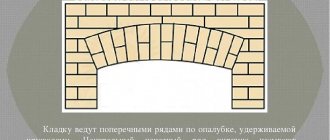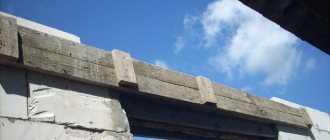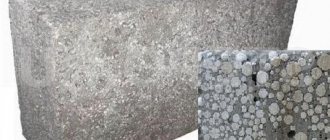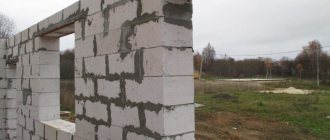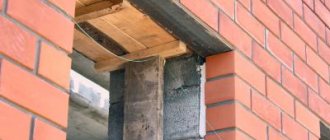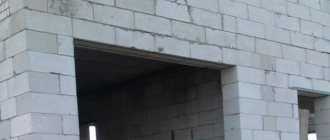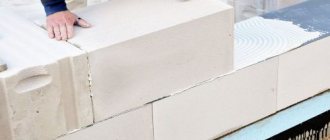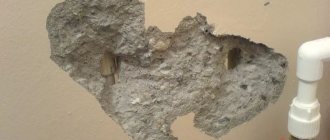When erecting brick walls, it inevitably becomes necessary to install a reinforced concrete lintel over the window opening. They are reinforced concrete beams with different sections and lengths, manufactured at the factory. To select the required standard size of the product, it is necessary to make preliminary calculations that will take into account such data as the load on the lintel and the width of the opening. Calculation of reinforced concrete lintels.
At the same time, when talking about the load, they mean the dead weight of the lintel combined with the weight of the wall and ceiling. In the case of residential buildings, where the loads are not so high, all cases are usually divided into three groups:
- The ceiling rests on the wall.
- The ceiling does not rest on the wall, and the wall itself is self-supporting.
- The lintel is laid in a brick partition 12 cm thick.
Lintels for window and door openings: types, sizes, installation features
It is difficult to imagine a house in which there are no windows or doors.
In order to make them, structures are needed to cover the openings. Reinforced concrete lintels are used for this purpose. Their main function is to transfer the load from the ceiling and brickwork to the side sections of the walls (piers).
The main materials for making jumpers are:
- Reinforced concrete - due to its affordable price and high manufacturability, is widely used in capital construction;
- Steel (I-beam or channel) is used to a limited extent to cover wide openings where windows and doors are subject to heavy loads.
The markings and overall dimensions of reinforced concrete structures are specified by GOST 948-84 . This building standard divides all industrially produced lintels for window and door openings into several basic types:
- PP - slab (width more than 25 cm).
- PB - block (width less than 25 cm).
- PG - L-shaped beams are equipped with a protrusion designed to support floor slabs.
- PF - façade (used for openings in which the masonry protrudes more than 25 cm from the wall surface).
Depending on the size of the working load, all prefabricated lintels are divided into load-bearing and non-load-bearing. The former perceive and transmit to the walls the weight of the ceiling and the upper part of the wall. The latter can only withstand the load from the wall and their own weight.
The load-bearing capacity of reinforced concrete lintels ranges from 100 to 3,700 kg/m. Concrete provides these structures with the necessary compressive strength, and steel reinforcement absorbs tensile forces.
What are lintels for aerated concrete blocks
If the wall dimensions are standard, the following types of products are used.
The masonry above the door or window opening is subject to additional load during the construction of the walls and during further use. The opening - the upper part and sides - is reinforced. Usually, to do this, grooves are cut out in the blocks that make up a row above the opening and iron rods are placed in them .
A house made of porous concrete of any type needs reinforcement. Every 4th top row, window and door openings must be reinforced. There is no need to use ready-made reinforced concrete structures for this. Aerated concrete lintels are much lighter, easier to install and do not create cold bridges.
To organize concrete lintels, formwork panels should be prepared according to the dimensions of the opening. To do this, first purchase wooden boards with a thickness of at least 20 mm, which will be fastened together with screws or nails. Experts advise using self-tapping screws, which can be easily removed later using a screwdriver.
At the next stage, the structure is reinforced. The diameter of the steel reinforcement is selected taking into account the load-bearing load of the lintel, its length and width. Metal rods are laid along the lintel, fastening them together with a special knitting wire.
Standard size range, weight and marking
The GOST dimensions of reinforced concrete lintels are as follows:
- length from 103 to 596 cm;
- height from 12 to 44 cm;
- width from 14 to 38 cm.
The weight of these structures directly depends on the dimensions and can range from 20 kilograms to 2 tons.
Reinforced concrete lintels are mounted on cement mortar. Cutting of these structures for the purpose of adjustment is not permitted. If the wall thickness is large, the opening is covered with several timber lintels, laying them parallel to one another.
Special markings help you understand the wide range of these products. It consists of three groups of alphanumeric symbols separated by a dash.
The first digit indicates the GOST number of the section. It is followed by two letters indicating the type of jumper and two numbers of its length (in decimeters). The second group of numbers contains information about the design load in kN/m. The third group of marking symbols is service and contains data on the degree of concrete density, the presence of mounting loops, the degree of seismic resistance or the class of reinforcement.
For example, let’s decipher the standard designation of a reinforced concrete jumper: 2PB22-3-p:
- 2 — section number (indicated in the GOST table);
- PB – bar lintel;
- 22 – length in decimeters (220 cm);
- 3 – bearing capacity (design load, 3 kN/m);
- p – the product has mounting loops.
To increase the load-bearing capacity of lintels, prestressed reinforcement is used. Such structures can be distinguished by the type of reinforcement indicated at the end of the marking. For example, 5PB21-27-AtV. In this case, AtV is a type of prestressed reinforcement.
Approximate prices and selection features
The most popular length of lintels used in residential construction is from 1.2 to 2.2 meters. The estimated cost of slab-type structures (width 38 cm) ranges from 600 to 4000 rubles. Bar lintels of similar length can be purchased at prices ranging from 250 to 1,700 rubles per piece, depending on the selected width and height.
When choosing the type of lintel above the windows, do not forget that slab lintels can only be installed in a non-load-bearing wall (on which the floor slabs do not rest). Bars can be installed in any type of enclosing structures (non-load-bearing and non-load-bearing).
The width of all manufactured reinforced concrete lintels is a multiple of the width of the masonry. Thanks to this, they are easy to choose for any object. For example, for partitions with a thickness of half a brick (12 cm) and one brick (25 cm), there are more than three dozen standard sizes of products ranging from 1 to 6 meters in length on the market. For thicker walls (1.5 bricks or more), the industry produces slab lintels.
For installation in non-load-bearing walls, it is more profitable to use slab lintels, because their width is equal to the width of the wall. In this case, you will have to use several pieces of timber beams.
When purchasing, you must take into account the support of the lintels on the wall - the main criterion for the reliability of the ceiling. If the area of the supporting part turns out to be less than the standard, then destruction of the material on which this structure rests may occur. To restore the load-bearing capacity of the pier, you will have to do the labor-intensive dismantling of the lintel, dismantling and re-laying the destroyed area.
In general, for a load-bearing brick or aerated concrete wall, the depth of embedding (support) of the lintel should be at least 25 cm. For a self-supporting wall, the size of its supporting part can be reduced to 12 cm. The lintel above the doorway should extend its ends onto the wall no less than 20 cm.
The height of the lintel is selected based on the calculated load on the opening. The developer does not need to perform complex strength calculations, since the full specification of these structures, indicating the dimensions, is contained in the design documentation. During independent construction, you should not engage in amateur activities with the selection of jumpers. It is better to contact the designers for advice.
The technology for installing lintels over openings is determined by the type of wall (load-bearing or non-load-bearing). In the first case, a powerful reinforced concrete beam is placed under the slab. Two other smaller sections are placed in the middle of the wall. The outer one goes down one row of bricks, forming a quarter.
In a non-load-bearing wall, the lintels are the same size. The outer one is lowered by a quarter, and the rest are placed at the same level.
Covering openings
Window, door and other openings in regular shaped brick and stone masonry are covered with lintels of various designs.
In general, jumpers are also divided into non-load-bearing and load-bearing.
Non-load-bearing lintels take the load only from their own weight and the section of masonry located above it.
Load-bearing jumpers. in addition to the weight of the masonry located above it, they experience the load from the ceiling resting on this section of the masonry.
The most effective and reliable lintels are made from prefabricated reinforced concrete elements and rolled metal (angles, channels, I-beams, rails, usually connected to each other by steel strips by welding). The designs of these jumpers are shown in Fig. 13, 14 and 15.
Rice. 13. Designs of lintels made of prefabricated reinforced concrete elements: A - for internal walls with a double-sided “bearing” load; B - for walls without floor beams; B - with a one-sided “bearing” load; G - for openings with a quarter; 1 - load-bearing beam; 2 - non-load-bearing beam; 3 - floor beam
Rice. 14. Designs of lintels using rolled metal: A - corner; B - channel; B - I-beam; G - rail; 1 - brick wall; 2 - strip steel 2×40 mm (every 250 mm)
Rice. 15. Design of lintels made of channels (A) and I-beams (B) with a load from the floor: 1 - brick wall; 2 - floor beam
Now about wedge, arched and circular lintels (Fig. 16, 17 and 18). They are formed from ordinary bricks, which are laid on the edge. The strength of such lintels is ensured by a wedge-shaped locking seam located in the upper part of the lintel with a thickness of at least 5 mm at the bottom and no more than 25 mm at the top. The lintels are laid on both sides in the direction from the heels to the middle (towards the lock) on a mortar with a grade of at least “25”. The bricks in the masonry are shifted in thickness by 1/4 of a brick.
Rice. 16. Wedge lintel: 1 - lock; 2 - heel; 3 - brick on edge; 4 - brick wall
Wedge and arched lintels allow a maximum span of 2 m with a lintel height of h = 1.5 bricks, with a rise of f = (1/10. 1/8)xl (see Fig. 17).
Rice. 17. Arched lintel: 1 - lock; 2 - heel; 3 - brick on edge; 4 - brick wall
The radial seams of the front row pass through the entire thickness of the lintel, the normal and vertical seams of the other rows are shifted relative to each other by no less than 1/4 of the brick.
The height of the circular lintel is also assumed to be h = 1.5 bricks, i.e. 38 mm, span no more than 3 m (see Fig. 18).
Rice. 18. Circular jumper: 1 - lock; 2 - heel; 3 - brick on edge; 4 - brick wall
Wedge, arched and circular lintels are placed on the formwork. The timing of the “removal of formwork” of the lintels depends on the outside temperature and is shown in the table.
Timing for “removing formwork” of lintels
Ordinary brick lintels with a span of up to 2 m are laid on a mortar of a grade not lower than “25”, and with a length of more than 2 m - on a mortar not lower than a grade “50”. If the pier width is less than 1 m, the lintel is laid across the entire pier.
Ordinary lintels are reinforced with steel wire with a diameter of 6 mm, which is located in a 30 mm layer of 25 grade mortar. "50" (Fig. 19).
Rice. 19. Ordinary brick lintel: 1 - reinforcement; 2 - brickwork; 3 - cement mortar
Such lintels are allowed to be constructed without calculation if the opening width is LL/3 from the top of the lintels and the load from them is less than 1 t/m.
The amount of reinforcement, brand of mortar and number of rows of masonry in lintels that do not meet the above requirements, as well as the conditions shown in Fig. 19, must be calculated in advance.
In the walls made of lightweight masonry, the systems of engineers Popov and Weinstein, which are presented in the article “Brick walls: materials, types, designs.” ordinary lintels are made of solid brickwork.
How to choose lintels for brick walls?
Purpose of the lesson: to consolidate theoretical material, learn how to select lintels over window and door openings to brickwork.
Contents of the lesson: on A4 graph paper at a scale of 1:100, draw up a plan diagram for the list of lintels according to the given options, fill out the list of lintels in Form 1 and the specification of precast reinforced concrete elements (Appendix A).
Initial data: diagrams of floor plans (based on materials from practical work No. 1). Jumper types are given in Appendix B.
Procedure for conducting the lesson:
1) Before proceeding with the selection of lintels, it is necessary to complete the floor plan diagrams for the list of lintels. An example plan is shown in Figure 6.1.
To do this, we schematically draw the floor plan of the house with the designation of openings, observing the scale. An example of the circuit is given in Figure 6.2.
2) Assign each opening a position (mark), which is assigned in accordance with the width of the opening and the static function of the wall - load-bearing, self-supporting or non-load-bearing. An example is given in Figure 6.3.
3) Determine the size of the opening: (width and thickness).
4) Select cross-sections of lintels, combining them from several bars or a combination of bars and beams. In load-bearing walls, place “load-bearing” lintels in places where the slab (beam) is supported, and fill the remaining width of the walls with “non-load-bearing” lintels. An example is given in Figure 6.4.
Section diagrams are drawn in table form 2.1 GOST 21.501-93.
Figure 6.1 1st floor plan
Figure 6.2 Layout of the 1st floor
Figure 6.3. Marking of openings
Figure 6.4 Diagram for installing lintels over openings in external load-bearing brick walls
For ease of work, keep a count of the required length of jumpers next to the sheet. To do this, we add to the width of the opening the value of the minimum support of the lintels on the wall: “non-load-bearing” lintel + 240 mm (120 mm on each side), “load-bearing” lintel + 500 mm (250 mm on each side). The brands of jumpers are indicated by positions on the section diagram. The “non-load-bearing” lintel takes only the weight of the masonry, and the “load-bearing” lintel takes the weight of the masonry and the floor resting on it.
5) Select “load-bearing” and “non-load-bearing” jumpers according to Appendix B.
6) In load-bearing, self-supporting walls and partitions, use only “non-load-bearing” lintels.
7) If a quarter is required, lower the external reinforced concrete lintel by a quarter amount equal to 65 mm.
 The selected brands of lintels are indicated in the specification of prefabricated lintel elements (Appendix A)
The selected brands of lintels are indicated in the specification of prefabricated lintel elements (Appendix A)
An example of selecting lintels in a building with brick walls
Guidelines: An example of selecting lintels in a building with brick walls. The thickness of the external walls is 510 mm, the internal walls are 380 mm.
Stage I. According to the plan, Figure 6.5, determine load-bearing and non-load-bearing walls
Along the axis, 1-window opening is 910 mm (load-bearing wall 510 mm thick).
Along axis 2 - doorway - 910 mm (load-bearing wall 380 mm thick).
Along axis A - doorway - 1010 mm (curtain wall 510 mm thick).
Along axis B there are 2 window openings – 1510 mm (curtain wall 510 mm thick).
There are two window openings of the same size on the building plan, so they will have the same lintel markings.
All openings have different widths, which means that the marking diagram should have four types of lintels: PR-1; PR-2; PR-3 and PR-4.
Figure 6.5 1st floor plan
Stage II . Draw a diagram of the 1st floor plan (Figure 6.6), indicating the positions of the openings. In the task it will look like this:
Figure 6.6 Scheme of the 1st floor plan with markings of openings
Stage III. Select “load-bearing” and “non-load-bearing” jumpers and sketch their diagrams:
1) To block an opening in a wall 510 mm thick, you will need four 120 mm wide timber lintels: 120 mm x 4 = 480 mm,
plus three 10 mm seams (10 mm x 3 = 30 mm). Thus, we get: 480 mm + 30 mm = 510 mm - a size equal to the thickness of the wall.
We have determined that the wall is load-bearing, so the outermost lintel on which the wall rests must be “load-bearing”.
We get: three jumpers – “non-load-bearing” and one – “load-bearing” (Figure 6.7)
Figure 6.7 Diagram of jumpers in a load-bearing wall 510 mm thick
2) To determine the length of the lintel to the width of the opening, add the value of the minimum support of the lintel on the wall (Figure 6.8 and Figure 6.9)
“non-load-bearing” lintels: 910 mm + 240 mm (120 mm on each side) = 1150 mm.
Figure 6.8 Scheme of supporting a non-load-bearing lintel over the opening
Using the table in Appendix B, we select the required size of the jumper, the size of which will correspond to the calculated length (in our example, 1150 mm). This turned out to be a jumper with the name 2PB13-1, the length of which is 1290 mm, height – 140 mm;
“load-bearing” lintel: 910 mm + 500 mm (250 mm on each side) = 1460 Figure 6.9 Scheme of supporting the load-bearing lintel over the opening
We find the required lintel in the table and do not forget about the design load (Appendix B), since the floor slab rests on the “load-bearing” lintel. We get a 3PB16-37 jumper, the length of which is 1550 mm, the height is 220 mm;
Jumpers PR-2, PR-3, PR-4 are selected using the above method.
When selecting a PR-4 lintel, it is necessary to take into account the wall thickness - 380mm.
In this case, 3 lintels with a width of 120 mm are laid above the opening:
120x3 = 360 mm; 360 mm + 20 mm (two seams of 10 mm each) = 380 mm.
3)We fill out the list of lintels according to form 6.1 - Figure 6.10, putting down positions in the section diagram, then fill out the table of specifications for prefabricated lintel elements (Appendix A). Examples of filling are given in tables 6.1 and 6.2.
Form 6.1 GOST 21.501-93
Figure 6.10 Jumper List
Table 6.1 Example of filling out the list of jumpers
Table 6.2 Example of filling out the specification of jumper elements
Prefabricated concrete lintels
Bed under the ceiling installation description
Since a brick lintel is a rather complex architectural element from a structural point of view, a beginner is unlikely to be able to make it correctly with his own hands right away. They are installed only over openings not exceeding two meters in width, and on walls that do not bear loads from the floors - after all, in terms of bending strength, they cannot compete with reinforced concrete lintels. Therefore, in private construction almost everywhere, even on narrow openings, they are used.
Supporting the lintel on the brickwork
The assortment of most reinforced concrete factories includes lintels for brick walls, manufactured according to standard 948, in force since 1984. This GOST regulates the production of heavy concrete lintels specially designed for brick buildings - and not only residential, but also for any other purpose.
They can also be used for installation in openings of walls built from stones of natural and artificial origin. The category of artificial stones includes, in fact, the brick itself, as well as all kinds of small-format blocks made of ash or autoclaved concrete.
Types and parameters
There are four types of lintels for such walls, and they differ in shape and size. For clarity, let’s present information arranged in the form of a table about what they look like and in what situations they are used.
| Product appearance | Purpose, dimensions |
| This type of lintel resembles the shape of a wooden beam. Its cross-section may be square, but if it is rectangular, then the height is greater than the width - for example: b-120 mm, h-220 mm. That is, in the design position the block should stand on the edge. The only option where the size b is greater than h is 120 * 65 mm. But it is only used on non-load-bearing walls. There are a lot of length variations: starting from 1030 mm and ending with 5960 mm. The maximum width of PB type lintels is 250 mm - which means they are used only in cases where the wall thickness does not exceed the length of one brick. |
| Lintels of this type are intended for walls whose thickness starts from 1½ bricks. They are always mounted flat, and accordingly, their width is greater than their height. In general, there are only 2 options for width: 380 mm and 510 mm. Height can be 65; 140 and 220 mm. Maximum length – 2980 mm. |
| Here we see that, unlike the two previous options, the cross-section of the lintel-beam is not rectangular, but stepped. The protruding shelf is needed so that the floor slab can rest on it. The total cross-sectional width is 250; 380 or 510 mm - according to the thickness of the brick walls. The height of the lintel and the height of the shelf, as well as their proportions, vary significantly. Product length is minimum 1550 mm, maximum 5950 mm. |
| In terms of configuration, the façade type lintel is very similar to the PG. The only difference between them is that the shelf has recesses at its ends. The drawing shows a top and end view. It shows that the shelf is shorter than the product itself on each side by the amount of “a”. Such a lintel, mounted on the wall, is visible from the facade - hence the name. A shortened shelf is needed so that it can cover the opening with a quarter. |
Nuances of installing concrete lintels
The technology for installing prefabricated reinforced concrete products is extremely simple, and therefore such lintels over windows can be seen much more often than any others. To install them, a ledge at least 25 cm wide must be provided in the wall on each side of the opening. That is, the length of the jumper should always exceed its width by half a meter.
All that is needed for installation is a truck crane that will lift a concrete beam or slab and lower it onto a support footing in the wall. On it, as when laying bricks, mortar is spread before installing the lintel. The horizontal position of the structure is verified by a level along the bottom edge.
Construction of a monolithic lintel
Sometimes the prefabricated version cannot be selected according to the width of the opening, and for walls of 2.5 bricks, ready-made concrete lintels are not produced at all. In such cases, formwork is installed over the openings, a frame is knitted from reinforcement, and the lintels are poured in a monolithic manner. How this looks can be clearly seen in the example presented above. The conventional removable formwork is shown here, but there are other options.
Trough expanded clay concrete block for lintel construction
For example, to fill a monolithic lintel, you can use concrete or ceramic U-blocks, which are used as permanent formwork. In all respects, they correspond to a conventional lintel, but have a cavity in which reinforcement is laid and concrete is poured.
How to calculate the load
Technically, the lintel at the top of the opening is a regular beam and the calculation for it is carried out in a similar way. There are two main requirements that this part must satisfy:
- The sections of the walls on which the lintel rests must adequately bear the load.
- The residual deformation (deflection) of the lintel under load should not exceed the permissible values for windows or doors installed in the opening.
It is always necessary to take into account the self-supporting properties of the wall. Very often, when constructing masonry, opening lintels perform their function only for the first 2–3 weeks after their installation, and then they simply remain in the walls without any need. This applies to those openings over which a masonry pillar is preserved, equal in height to the length of the span. Here, a lintel is not needed at all - the wall will support itself, and the larger the blocks used for masonry, the smaller the height of the pillar should remain.
In other cases, the jumper is calculated based on the applied load, including:
- own weight of the jumper;
- the weight of the wall taking into account its self-supporting capacity (the height of the masonry above the opening);
- distribution of the weight of the wall (for summer masonry, only 1/3 of the width above the opening is taken into account, for winter masonry - the entire wall);
- the load caused by the support of beams or floor slabs on a given section of the wall.
The linear dimensions of the jumper are also important. Its width is determined by the thickness of the wall, its height by the required load-bearing capacity. The length of the lintel corresponds to the width of the opening plus twice the depth: from 10 cm for brick walls and up to 30 cm for loose porous blocks.
In most cases, to determine a suitable lintel, it is enough to make a selection from tables with standard prefabricated concrete products (series 1.038 for standard and 1.225 for very wide openings). The required product is determined by the width of the opening, taking into account the depth of the filling. If the required lintel is thinner than the wall, you need to install several of these, or at least two of them.
Of course, no one insists on purchasing finished products. You are free to cast reinforced concrete lintels yourself, as well as replace them with wooden or steel ones at your discretion, having first performed a calculation of the lintel for deflection.
Installation of lintels in stone buildings
The easiest way to decorate the upper part of the opening is to avoid using a lintel, increasing the height of the window right up to the reinforced belt. This is not always possible, because the length of the span imposes its own limitations, especially for load-bearing walls, and besides, it is impossible to bring doors right up to the ceiling. And yet you should know that between the opening and the reinforced crown there must be at least two rows of large-format blocks, or 5-7 rows of bricks, or there should be nothing.
It is easiest to arrange the upper part of the opening in walls on which the ceilings do not rest. If the height of the masonry above the opening does not meet the requirements for self-support, the upper rows are reinforced with reinforcement. Between each brick of the row covering the opening, “clips” are laid - clamps made of 4 mm wire, which protrude above the row of masonry, forming a kind of ears. Under them, longitudinal reinforcement is inserted and tied, one 10 mm rod for every 10 cm of wall thickness, extending 15–20 cm onto the pillars on the sides of the opening.
Strengthening an opening in load-bearing walls made of solid blocks of lightweight concrete is even easier. The masonry above the opening is carried out using a temporary support from below. After this, a groove up to 20 cm deep and 25–30 mm thick is cut in the center of the blocks above the opening. Flat reinforcement is inserted inside - a mesh of 12 mm reinforcement, and then the groove is filled with sand concrete. If it is clear that such strengthening does not meet the strength requirements, use U-shaped trays made of porous concrete in the manner of permanent formwork.
Reinforced concrete lintels are very significant cold bridges. Their use is required only in exceptional cases, when a very wide opening is planned in the load-bearing wall. Such lintels are cast flush with the wall, tamping the panel formwork from the inside, outside and below. The lintels are reinforced in two rows, one 12 mm rod for every 60–80 mm of wall thickness. Depending on the length of the span, another 2–3 reinforcement bars can be added to the bottom row of reinforcement. To prevent heat migration, a pair of EPS slabs with a total thickness of 50–70 mm are installed in the center of the formwork, while the reinforcement is distributed to form protective layers of 40 mm.
When installing jumpers of any type, it is important to be able to properly prepare the “shoulders” on which they rest. As a rule, wood, solid brick or grade 300 cement mortar are used for this.
Technology for making ordinary jumpers
- Tool. To install an ordinary lintel, you will need the same tool that is used to lay regular brick walls.
- To create reinforced support for bricks, formwork must be installed. To make it, you will need boards 40-50 mm thick.
- Before starting work, it is advisable to protect the boards with plastic film or roll waterproofing. This will prevent the masonry compound from leaking and give the lower part of the lintel a more even appearance. It should be taken into account that any unevenness on the surface of the formwork can negatively affect the appearance of the opening being constructed.
- The mortar mixture is spread on the formwork. Reinforcing bars are laid on it and then embedded in this composition.
- Then the reinforcement is covered with a second layer of mortar. Its thickness should not be less than 3 cm, since this layer provides protection to metal products.
- To ensure the stability of the formwork, bricks are made from the masonry. After the mortar has gained full strength, remove the boards and cut down the protruding brick. You can use another option - make a furrow in the masonry, place the formwork in it, and after removing it, install a brick there with a masonry joint. In this case, the support boards can be installed on the edge for rigidity.
Strengthening openings in frame buildings
For a frame building, the presence of lintels in the upper part of the openings is strictly necessary. The requirements described below are valid for frames made of both metal and wood.
If the width of the opening does not exceed two steps for installing the frame racks, the nearest side rack elements are connected by two horizontal crossbars, and then two vertical spacers are added between them, setting the required width of the opening.
If the opening width is equal to three or more distances between the frame posts, it is decorated with crossbars in the same way. For additional support of short racks above the opening, they are unloaded onto adjacent ones using diagonal braces running from the center outward. In all cases, the cross-section of the crossbars should not be less than the size of the rack elements of the frame.
If the opening exceeds the width of five times the distance between the posts, the verticals closest to it should be double. The internal pair is connected to each other by a horizontal jumper, and the external one is the same, but higher by half the height of the opening. The space between two horizontal crossbars is filled with a diagonal stiffening mesh based on the principle of floor trusses.
Process
The arrangement of lintels, with the formation of a unit and taking into account support in the wall, must take place according to the rules described in SNiPs. Since reinforced concrete lintels are used most often in modern buildings, the process of their installation consists of the following nuances:
Metal jumpers are lightweight. Presented in the form of channels and various forms of rolled steel, their advantage is that during operation they can be cut to the required length.
Brick lintels are mounted to the main wall along the top of the opening , and then connected to each other using a shelf from which clamps hang, placed in vertical seams. The clamps reliably reinforce the lintel, and it turns out strong.
Experienced craftsmen choose longitudinal, wedge, beam or vaulted installation methods. Concrete mortar for laying is mixed in small portions so that it does not harden quickly.
Recently, in most cases, builders have placed the professional BAUT reinforcement system into brick lintels.
A simple and reliable way to install a brick lintel - in the video:
How to make and strengthen openings in load-bearing walls
When remodeling, it may be necessary to make an opening in a load-bearing wall. Such actions in the public sector can only be carried out in agreement with the housing stock, while private developers can act at their own peril and risk.
According to the project, the boundaries of the future opening are marked on both sides of the load-bearing wall. To ensure complete coincidence, after marking, four strictly perpendicular holes are drilled on one side in the corners of the opening and connected with lines.
Along the upper border of the opening, a horizontal trim is made about 10 mm wide and 20 cm longer than the opening in both directions. A piece of angle steel is placed into the resulting groove on each side. Its cross-section can be determined by bending calculations, but more often the embedded parts are made with great excess strength. In general, a steel angle 100x100x8 mm will be more than enough.
Above the nested corners, one hole is drilled for every 25 cm of the opening width; smooth fittings are inserted into them, through which the corners are connected to each other. The lower ligament is made with overhead steel plates 100x8 mm. After installing the lintel, the opening can be cut out and removed piece by piece.
In the lower part of the opening along the plane of each wall, two pieces of corner steel with dimensions of at least 50x50x4.5 mm must be laid. They need to be inserted into the wall at least 50 mm on each side. Vertical side corner covers are inserted between the lower and upper corners. They are usually chosen to be equivalent in size to the top frame.
On the inside, the side corners are connected with overhead plates. In the wall, the harness is secured with pins made of 12 or 14 mm profile reinforcement, which are driven into holes drilled at an angle of 45° to the wall plane every 35–40 cm. The pins are secured to the corners by welding, cut to 60–70 mm, and then tightly are bent to the plane of the frame and thoroughly scalded.
Types of products
The lintels used for arranging brick walls are different:
Reinforced concrete
Reinforced concrete products are prefabricated and monolithic. Prefabricated ones include the following types:
There is also a facade type of lintel, but experts often classify it as PG, but with a slight difference - at the ends the shelf is made with recesses, and is clearly visible from the facade.
PP and PB are considered interchangeable . They have identical height and length, but differ only in width. This option is used if there are no slab-type lintels available at the construction site.
Monolithic lintels are installed in the wall itself using formwork. At the same time, they calculate the height of the structure (1/10-1/12 of the opening dimensions), with mandatory reinforcement (metal rods with a diameter of up to 12 mm).
The reinforcement is poured with a concrete composition with a thickness of at least 20 mm.
Metal
For such jumpers, rolled steel is used . They can make floors of 2-5 m, and they can be laid in both load-bearing and non-load-bearing parts. For brick walls, along with reinforced concrete products, this is one of the ideal options.
This product will withstand very heavy loads, as it is durable. Since such jumpers can be of any length, there are no questions when arranging openings of non-standard width.
Steel corners have a number range; numbers 10-12 are especially recommended .
Brick
They can be arranged in a straight line or curved (arch). The rectangular version is laid on the formwork, according to the rules for laying and tying bricks. Here you can create a wedge shape along the vertical seams of the masonry.
It is necessary to ensure that the seams are inclined and there is no vertical movement of the bricks. The work must take into account the width of the opening.
The curved lintel is laid using a wedge method, with emphasis on compression. Arched segments are obtained due to special laying with an edge, where the seams of the laid bricks open up.
The lifting booms are located in the range of 1/6 - 1/10 of the opening width. Curvilinear arches are laid out on a specially made circle - an arched device made of metal or plywood.
floor composition for laminate
In practice, a metal circle for arches is more preferable, since its shape is easy to align or bend.
Wooden
This type of lintel is made from good quality boards, special plates and logs with edging and timber.
The ends of such structures are embedded into the wall, no less than 25 cm. Wooden lintels are easy to build with your own hands. They can last for many years (more than 50 years), but must be insulated from moisture penetration.
Therefore, when installing them, the products must be wrapped in insulating material (made of polypropylene, rubber, roofing felt, polyethylene). In modern construction, such floors are used less and less, despite their most affordable cost, since products made of reinforced concrete and metal are more durable.
Cellular prefabricated
Such products are made from cellular concrete , which can be reinforced and arched. The height of such a lintel is 125 mm, and the depth of its support is 200-250 mm. This type of lintel for brick walls is not yet very common.
Many experts believe that this material is more suitable for a wall built from the same cellular concrete.
Reinforced brick
They are made of brick and reinforcing metal components - hence their name. They are created according to the same principle as brick ones - straight or arched.
The reinforcement used in their arrangement is 6-10 mm. It is laid in formwork, filled with concrete solution. This protects them from corrosion.
There is another way of laying this type - in the form of a collapse vault. Only a professional can perform this method.
Each of the listed types of jumpers is good in its own way . Which one is suitable in each specific case depends on the time of construction (renovation of an old building, new building), additional materials used, in addition to bricks, the existing plan and structure diagram (drawing), the wishes of the customer and the material component.
Calculation of reinforced concrete lintels.
When erecting brick walls, it inevitably becomes necessary to install a reinforced concrete lintel over the window opening. They are reinforced concrete beams with different sections and lengths, manufactured at the factory. To select the required standard size of the product, it is necessary to make preliminary calculations that will take into account such data as the load on the lintel and the width of the opening. Calculation of reinforced concrete lintels.
At the same time, when talking about the load, they mean the dead weight of the lintel combined with the weight of the wall and ceiling. In the case of residential buildings, where the loads are not so high, all cases are usually divided into three groups:
- The ceiling rests on the wall.
- The ceiling does not rest on the wall, and the wall itself is self-supporting.
- The lintel is laid in a brick partition 12 cm thick.
Consequences of errors
To avoid problems in the form of consequences during the construction process, it is better to entrust the selection of lintels to a professional construction engineer.
Based on an examination of the load-bearing capacity of the wall, the depth of support, and a number of mandatory characteristics, he will carry out the necessary calculations and determine exactly what material, shape and size the lintel will be suitable for in this particular case (length, width, thickness).
The consequences of errors are destruction, cracks, and displacement of bricks. To prevent them from arising, you must observe the following nuances:
Types of reinforced concrete lintels.
Before we begin the calculations, let's take a little look at the types of jumpers themselves. To understand what options are available to you, you should open the website of any reinforced concrete manufacturer and see what types of reinforced concrete lintels are present in their product range. By clicking on the link, you will see a long list of standard sizes with their characteristics. To learn how to quickly navigate it, you should learn to decipher the markings. Let's do this using the example of a 2PB 16-2 jumper:
- 2PB - this part of the marking means that the product belongs to a certain type and type of section. In this case, a timber lintel of the second type of section . Bar lintels (PB) can have a width of 120 or 250 mm, which makes it necessary to use several products at once in cases where the thickness of the partition exceeds 120 mm. They also produce slab lintels (PP), the width of which is 380 and 510 mm.
- The second type of section (2PB) has dimensions of 120x140 mm. Other types have the following dimensions: 1PB - 120x65 mm, 3PB - 120x220 mm, 4PB - 120x290 mm, 5PB - 50x220 mm.
Now, knowing the variety of reinforced concrete lintels, you can proceed directly to the calculation.
How to select reinforced concrete lintels.
Calculation of reinforced concrete lintels. So let's first enter some initial data. Let's say we need to calculate which lintel should be used to cover a span of 1350 mm wide in a self-supporting wall 240 mm thick with a wall height above the opening of 800 mm. Construction is being carried out in winter conditions.
A wall thickness of 240 mm means that we will need two lintels 12 mm wide. In winter, a load from the height of the wall equal to the design span is taken on the self-supporting lintel. The design span is calculated as follows:
1350 + 2*100/3 = 1420 mm
100 mm in this case is the minimum depth of support for the lintel. Since the height of the masonry turned out to be less than the design span, in future calculations we will use exactly this height - 800 mm.
Next, we determine the load per 1 linear meter of the product:
0.24*0.8*1.8*1.1/2 = 0.19 t/m = 190 kg/m
In these calculations, 1.8 t/m3 is the weight of the brick, 1.1 is the safety factor, 2 is the number of lintels. So, we need to choose a jumper from those whose load index is at least 2.
As we said above, the minimum support depth for these jumpers is 10 cm, which means the smallest possible length of the jumper in our case is:
1350 + 100*2 = 1550 mm
From the list of standard sizes, a 2PB 16-2 jumper with a length of just 1550 mm and a design load of up to 200 kg/m could suit us. However, we still need to take into account the load from the beam’s own weight, which is 70/1.55 = 45 kg/m. That is, the total load will be 190 + 45 = 235 kg/m, which exceeds the maximum permissible for this jumper.
In our case, a 2PB 19-3 jumper is suitable. Its own load is 80/1.94 = 41 kg/m. Then the total will be equal to 190 + 41 = 231 kg/m, which does not exceed the permissible 300 kg/m for this beam. The length of the lintel is 1940 mm, and this is also suitable for our conditions.

